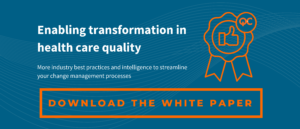Featuring: Jake Lazarus – Advisory Solutions, senior consultant
There’s no one-size-fits-all answer to developing a successful quality program, but observing distinct approaches reveals valuable lessons in creating effective and sustainable strategies.
Jake Lazarus, a senior consultant with the Advisory Solutions team at Q-Centrix, has worked with several prominent health systems throughout his career, including BJC HealthCare in St. Louis, the University of Chicago Medicine, Massachusetts General Hospital, Indiana University Health, and NorthShore University Health System in suburban Chicago.
As a practice manager, he witnessed firsthand how quality programs operate and interact throughout the systems that built them. Here, he shares lessons learned while enabling transformation in health care quality, strategies that delivered results, and a few common pitfalls to avoid.

Change management strategies that work
1. Staff Ownership
One of the most successful initiatives I participated in involved empowering staff to take ownership of improvement. An idea system, which is a structured way for front-line staff who have identified improvement opportunities to engage leaders, was implemented in one area of the organization as a trial. The near-immediate success of this process led to its spread in many other departments throughout the system.
The benefits of an idea system are two-fold: First, they lead to process efficiencies and cost savings. Even if they are small, incremental improvements, they add up over time. Second, they help create a stronger culture of improvement within the staff, shifting perspectives from complaints to a culture of curiosity and engagement in change. Staff were more invested in improving and no longer felt like changes were imposed on them.
2. Investment
Another attribute of a strong program is investing resources up front to develop lasting improvement systems. Buy-in for this idea will likely be challenging given the health care industry’s present financial climate, but when done correctly it will almost certainly lead to positive ROI.
Resources can include personnel, hiring external help to develop a system that works for you, or developing resources for your staff to drive improvement.
3. Daily commitment
One of the most successful quality programs I experienced was sustainable because it promoted daily improvement across all areas of the system. Every part of the organization, from the operating rooms to the environmental services office, had visible and centrally-located Managing for Daily Improvement (MDI) boards where front-line staff would hold daily huddles to discuss the prior day’s outcomes, emerging trends in their data, and opportunities to drive improvement. Each area had key performance indicators that they identified and tracked, and the entire organization had well-organized data operations to ensure their decisions and directions were evidence-based.
4. Leadership Engagement
Leadership engagement is paramount to the success of any quality program. One system that conducted weekly Rapid Improvement Events had Friday report-outs in an auditorium for any staff to see. The President and CEO of the system would attend every week – often with other senior leaders – and this had a significant effect on organizational culture.
- Team members could witness hospital leaders engaged in their work
- Hospital staff from any position had the opportunity to present to the top executive in the hospital, helping staff feel valued more so than any pizza party, or town hall meeting.
The common thread through all these points is gaining buy-in from every level of the organization, as everybody from senior leaders to front-line staff enhanced the process and invested time and resources to ensure a strong return, whether financial or outcomes related.
Pitfalls to avoid
While it’s encouraging to see the effective transformational practices occurring throughout healthcare, it’s also frustrating to witness systems working hard with little success.
Top-down culture
While centralized quality programs are critical to maximizing efficiency, consistency, and progress, local teams and front-line staff need to be given the opportunity to identify and engage in their own improvement efforts as well. Essentially, centralization and local empowerment are not mutually exclusive, and both are necessary.
Teams need to feel empowered in their work and will not embrace change if it feels forced on them without any opportunity for input. This approach will lead to resistance and wasted effort, as well as a lack of accountability, which will compound the longer that culture remains. When non-leadership roles are excluded from quality improvement initiatives, missed opportunities and ineffectiveness abound. Teams in these top-down atmospheres often feel helpless in communicating even the most necessary of changes, let alone the non-essential improvement ideas.
Change denial
It can also be costly when an organization is in denial of challenges in the current methodology. Resistance to change can lead to an underappreciation of the partners and assets that help create organizational stability in the long run.
Under-prioritization
As a practice manager over multiple divisions, it took me a year to learn of the transformation office within the organization. I had no access to real-time data, and the only organizational improvement effort I was aware of was related to Press Ganey patient satisfaction scores.
Change absolutely cannot occur when staff is not engaged. A lack of engagement may result in a change-averse culture, where teams are content with the current state, and the organization struggles to keep up with the changing healthcare landscape. This may also result in a reactive culture, where change only occurs after something bad happens, such as a negative patient outcome.
Creating your own quality transformation program
In short, there are many varying quality and transformation methodologies, all of which claim to be the most effective. In reality, the best option is the one that fits your organizational structure and culture. Most importantly, put the right pieces in place to empower agility and excitement throughout the organization, allowing the culture to evolve organically towards effective improvement.
Jake Lazarus is a senior consultant with the Advisory Solutions team, responsible for conducting the enterprise assessments to help health care organizations advance their quality journeys.
